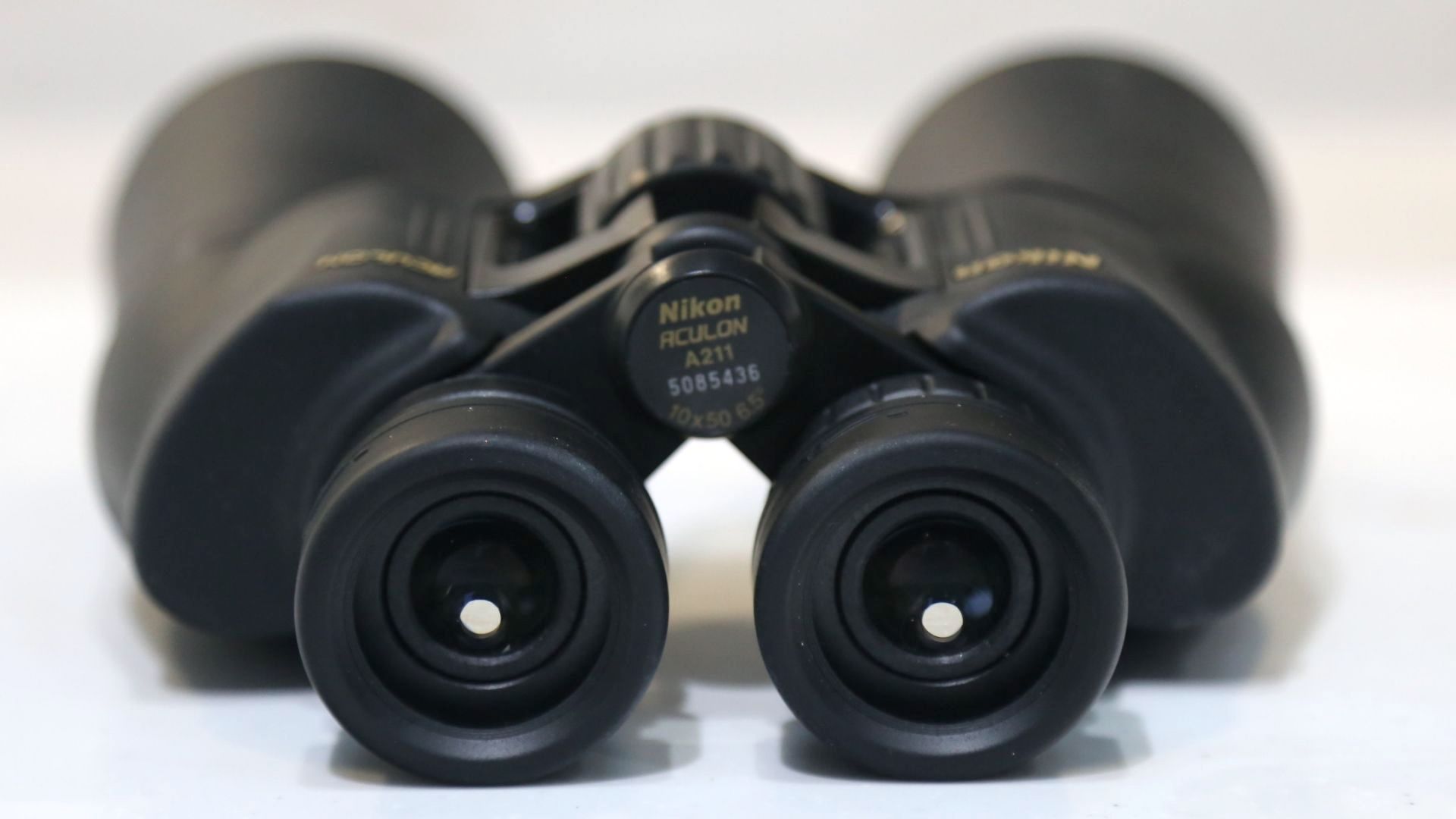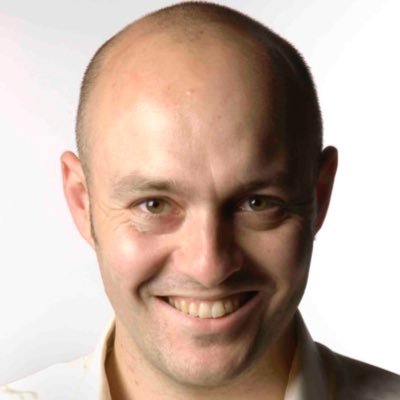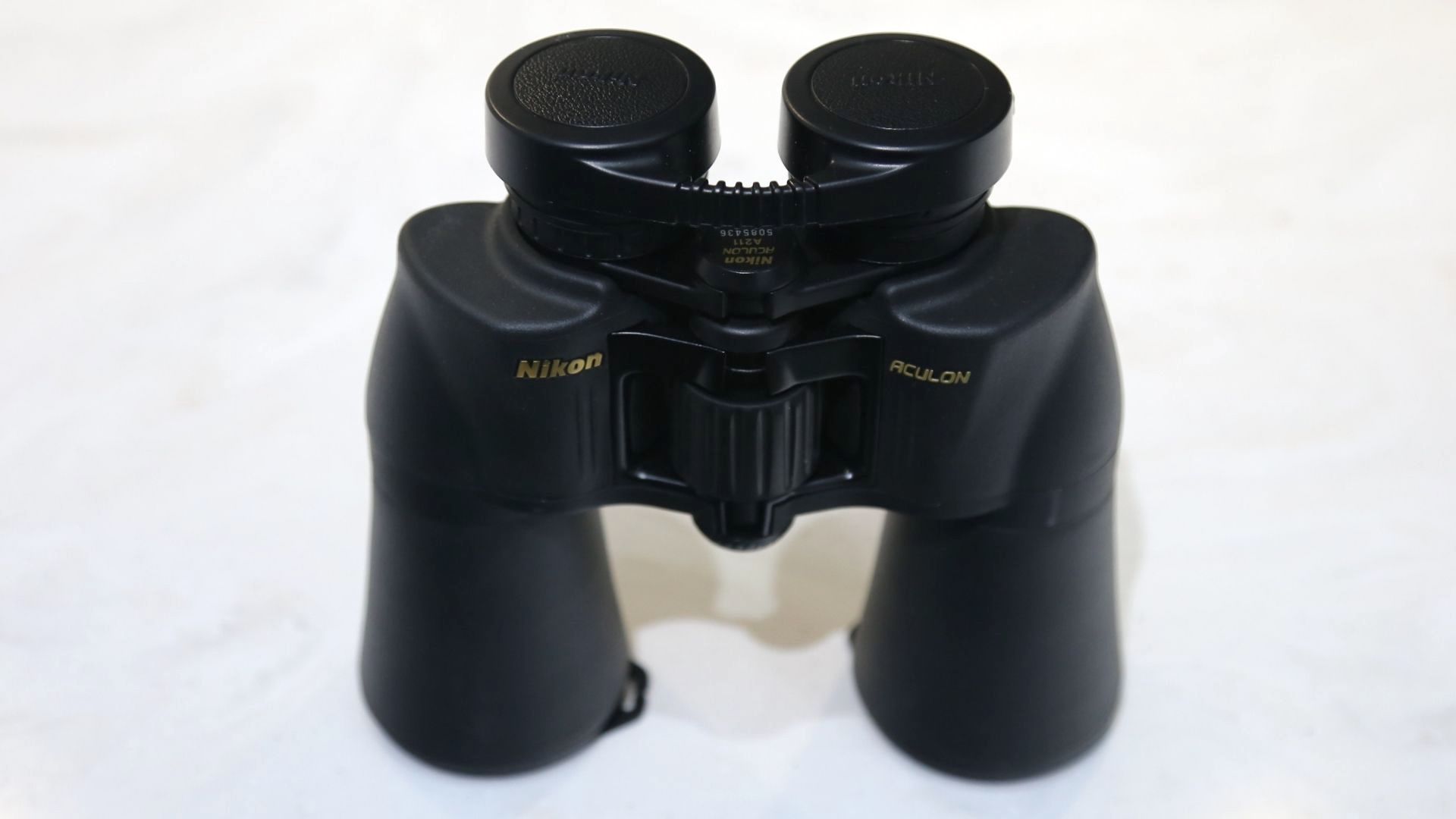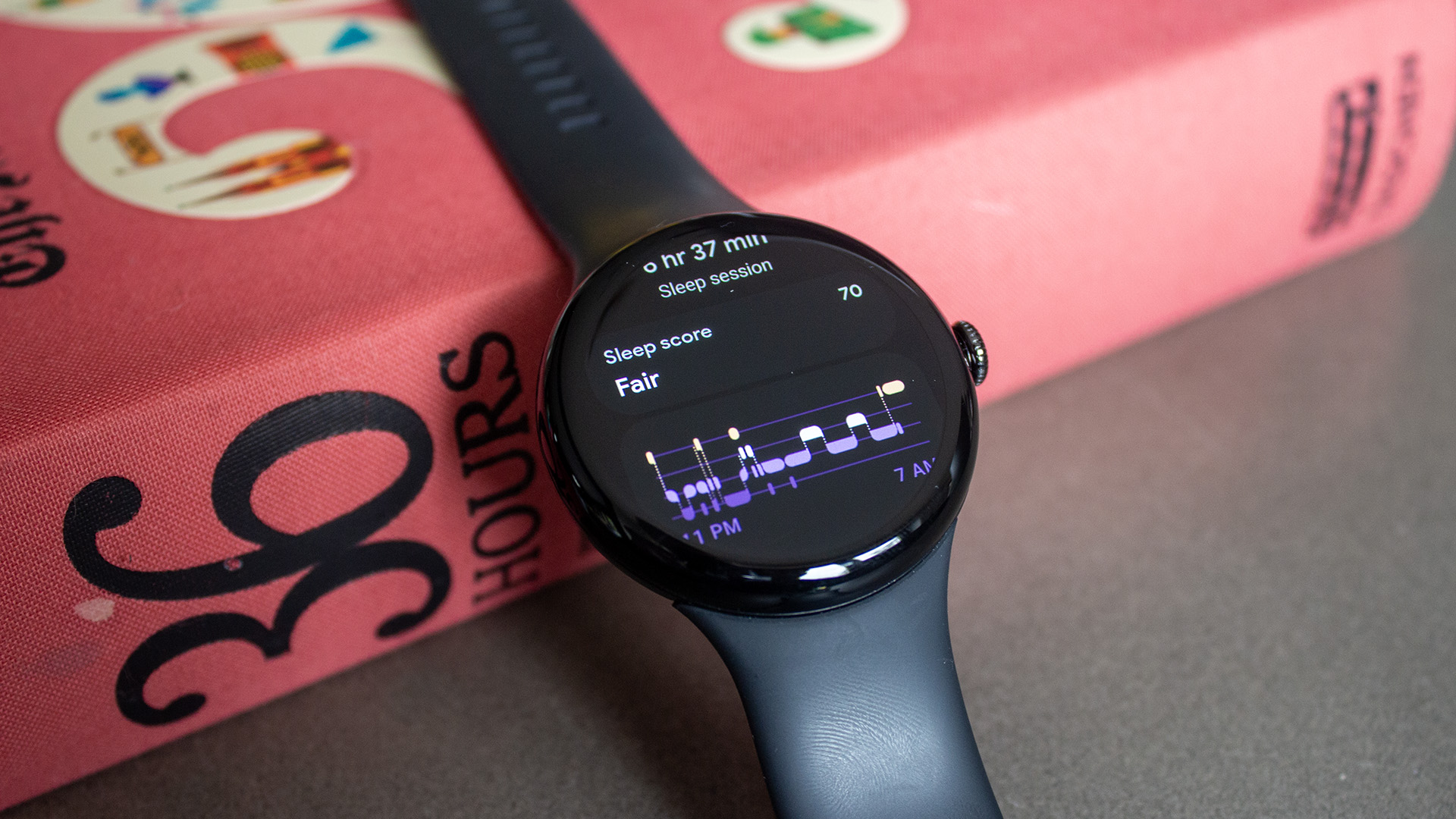Nikon 10x50 Aculon A211 binoculars review
Bulkier but brighter than rivals, the Nikon 10x50 Aculon A211 are among our favourite all-round binoculars for safari, stargazing and more. Here's our review

An excellent value pair of binoculars ideal for all-round use, the porro prism Nikon 10x50 Aculon A211 binoculars are a great option for wildlife, stargazing and general use, though they are bulkier and heavier than most rivals.
-
+
Excellent build quality
-
+
Bright and colourful images
-
+
Affordable price
-
+
Easy to use
-
-
Bulky size
-
-
Can't focus on close objects
-
-
Fiddly objective lens caps
Why you can trust T3

The Nikon 10x50 Aculon A211 are not the easiest binoculars to travel with. Weighing a whopping 899g / 31oz, these porro prism binoculars are on the heavy side. They're also wider than most binoculars, so why do I like them so much? Wearing a tough rubber armour that's nicely textured and easy to hold, these binoculars are that rare kind of product that seems like it could last for many, many years.
They're made of tough stuff, and that includes their optics, which help create stunningly colourful, crisp and sharp views both in bright conditions and in dusk, twilight and even during darkness. These factors mean that despite their weightier build, they're still a consideration for our best binoculars for birdwatching ranking.
There's something else that's unusual about the Nikon 10x50 Aculon A211 that I like. They're a relatively rare example of mid-range binoculars that employ that porro prism optical engine, which is known for both its affordability, but also for the brightness of its images. Here is why I enjoyed using the Nikon 10x50 Aculon A211 and why you should consider they're some of the best binoculars you can buy if you're looking for your first serious pair for all-round use.
Nikon 10x50 Aculon A211 binoculars review: price and release date
The Nikon 10x50 Aculon A211 cost around UK£99 / US$120 / AU$159 and originally went on sale in 2013 as binoculars for outdoor activities including birdwatching, nature observation and hiking. They're one of seven different models in Nikon's Aculon A211 range, which also comprises models with the following specifications; 10x42, 12x50, 16x50, 7x35, 7x50 and 8x42. 'Aculon' combines the words accuracy and precision.
Nikon 10x50 Aculon A211 binoculars review: design and features
Nikon 10x50 Aculon A211 binoculars specs
Magnification: 10x
Objective diameter: 50mm
Field of view at 1000m: 113.2m
Closest focusing distance: 7m / 23 ft
Eye relief: 11.8mm / 0.46-inch
Weight: 899g / 31oz
Dimensions: 19.7 x 17.9cm / 7.8 x 7"
The most important features on the Nikon 10x50 Aculon A211 are its 10x magnification and 50mm objective lenses, which make them ideal for all-round use. That 10x magnification is capable of wowing first-time users of these relatively large binoculars while the 50mm objective lenses ensure bright images even in low-light conditions, such as around dawn and dusk, in twilight, and at night.
Unlike most mainstream binoculars the Nikon 10x50 Aculon A211 uses the porro prism optical design. In use since the mid-19th century, this design sends light through a pair of glass prisms that magnify and correct the image for the lenses. This simple optical design means a really bright image and a wide field of view – two characteristics of the Nikon 10x50 Aculon A211 I definitely noticed during use – but it also means a slightly awkward Z-shape on each side. That explains why these binoculars are wider than a lot of rivals. They ship with a suitably wide padded bag, which can be used as a shoulder bag in conjunction with the excellent next map also included in the box. That bag also has a belt loop built into it.
The Nikon 10x50 Aculon A211 uses BaK-4 glass, multi-coated lenses to stave off reflections and aberrations, and also aspherical eyepiece lenses. The latter are there to reduce image distortion at the edges of the lenses.

Nikon 10x50 Aculon A211 binoculars review: build and handling
The Nikon 10x50 Aculon A211 is an unusually tough-looking pair of binoculars, but there's a catch; the use of that porro prism optical design means they're never going to compete with roof prism binoculars when it comes to portability.
The rubberised materials that completely cover the barrels on the Nikon 10x50 Aculon A211 are textured, which makes them easy to grip and hold in all kinds of weather conditions. It also lends them a degree of shock-resistance. Despite the fact that the Nikon 10x50 Aculon A211 is not technically water resistant, I didn't have any issues with taking them outside in all kinds of weather.
During my time with the Nikon 10x50 Aculon A211 I found the build quality to be excellent, with the focusing knob nicely resistant to being knocked and the diopter adjuster similarly solid. The eyecups are also solid, though soft enough on the eye sockets (though they do lack eye relief for spectacles-wearers), with an excellent figure-of-eight eyecup cover that's sturdier than on most binoculars. However, the objective lens caps are slightly annoying. They stay in place well enough, but they're not attached either to each other or to the binoculars, so they're easy to misplace.
Nikon 10x50 Aculon A211 binoculars review: performance
I took the Nikon 10x50 Aculon A211 on a hike along a coastal path and was impressed by their all-round talents. Their key skill is brightness. Although I did notice some softness around the very edge of the field of view, the Nikon 10x50 Aculon A211 gives nice bright, clear and colourful images in all kinds of light. I used them in the middle of the day to view seabirds, during dusk to look at distant boats and at night to study the stars, and found them to be incredibly versatile and impressive. The wider field of view (when compared to roof prism binoculars with the same specifications) is handy for landscapes and for the night sky. The lack of close focus (objects need to be at least 7m / 23ft distant to come into focus) was only occasionally an issue, but it might be a deal-breaker if you want to use them in a small back garden.
The main problem with the Nikon 10x50 Aculon A211 is that they're heavy. At 899g / 31oz I found that my arms got more tired more quickly than when using lighter binoculars. That's important because the more tired your arms get the less likely you are to be able to hold a pair of binoculars steady. There are lots of techniques to reduce this problem, such as leaning back against the wall or even placing your binoculars on an upturned broom for extra support. You can theoretically attach the Nikon 10x50 Aculon A211 to a tripod using an L-shaped adapter that can be fastened to a hidden thread between the barrels. It's hidden under a small coin-sized, Nikon-badged cover. However, at 10x magnification we don't suppose many people will want to use that (if you do, it's worth investing in a travel tripod).
Nikon 10x50 Aculon A211 binoculars review: alternatives to consider
If the Nikon 10x50 Aculon A211 is too rich for you then consider something a bit more affordable like the Celestron UpClose G2 10x50. Another pair of porro prism binoculars, they're lighter and so easier to hold for long periods, but lack ultimate image quality and the build quality of the Nikon 10x50 Aculon A211. If you want something as portable as possible for travel, but still want impressive images then consider the Celestron TrailSeeker 8x42 roof prism binoculars, which offer less power but are ideal for travelling light.
Nikon 10x50 Aculon A211 binoculars review: verdict
They may not be the lightest pair of binoculars round, but the Nikon 10x50 Aculon A211 are incredibly versatile. Able to produce bright, sharp and colourful images across the board and boasting excellent build quality, they're let down only by their bulk and their lack of ultimate close focus. I think the Nikon 10x50 Aculon A211 is best considered not for viewing birds in a small back garden, but for using outdoors with landscapes, on safari, and for entry-level stargazing.
Sign up to the T3 newsletter for smarter living straight to your inbox
Get all the latest news, reviews, deals and buying guides on gorgeous tech, home and active products from the T3 experts
Jamie is a freelance journalist, copywriter and author with 20 years' experience. He's written journalism for over 50 publications and websites and, when he's not writing, spending most of his time travelling – putting the latest travel tech through its paces.
-
 Google Pixel Watch 3 just got a potentially life-saving update in the US
Google Pixel Watch 3 just got a potentially life-saving update in the USThe latest update brings advanced heart monitoring to American wrists
By Matt Kollat Published
-
 Polar’s new subscription feature lands in the shadow of Garmin’s Connect+ rollout
Polar’s new subscription feature lands in the shadow of Garmin’s Connect+ rolloutPR genius or timing disaster? Polar’s new Fitness Programme adds adaptive training to its ecosystem
By Matt Kollat Published
-
 New Orient Star watches offer a glimpse of the magic within
New Orient Star watches offer a glimpse of the magic withinThere are two new skeleton pieces
By Sam Cross Published